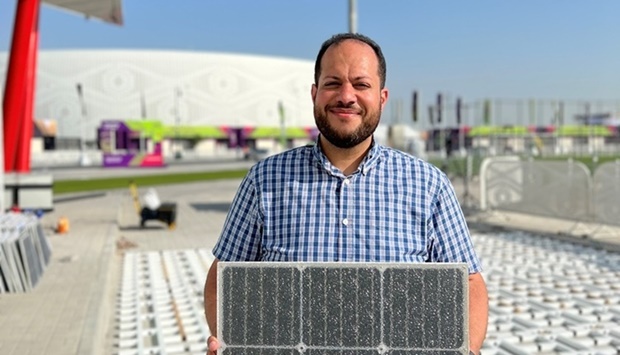* Patented panels to be tested at Al Thumama Stadium’s ticketing centre
The upcoming FIFA World Cup Qatar 2022 will feature a unique, innovative way of generating solar power, one that could revolutionise sustainability in the country moving forward. SUNPave, one of the winners of Challenge 22 – an initiative to encourage innovators to develop groundbreaking solutions and technologies to contribute to the FIFA World Cup Qatar 2022 has created solar panels you can walk on.
Embedded within tiles, SUNPave’s patented walkable class of solar panels will be tested out publicly for the first time in a dedicated area at Al Thumama Stadium’s ticketing centre – one of the eight World Cup stadiums. Mohamed AlGammal, co-founder of SUNPave, and a staff member at Texas A&M University at Qatar – a Qatar Foundation partner – believes this is a huge step towards a more sustainable environment. “Conventional solar panels tend to take up a lot of space,” said AlGammal, explaining how this – alongside an increase in demand for power – has proven to be a challenge in the past.
“But we don’t have that problem with our tiles.
“More so, solar panels typically have to be angled a certain way to ensure we generate the most power from the sun. The novelty of our design is that we’ve integrated a feature that allows for the same amount of energy to be captured despite the tiles being placed flat on the ground or vertically on a wall.”
At the stadium, SUNPave is installing tiles covering an area of about 50sq m – roughly enough space needed to park four to six cars. “The amount of energy that can be generated from the tiles installed in this space is enough to power a three-bedroom apartment, including all utilities like air conditioning, lighting, and refrigerators.”
The reason this solution isn’t as commonplace is due to the fragility of solar cells – they can shatter instantly when tampered with.
AlGammal and his team worked tirelessly to find a way to ensure the cells would be unharmed when placed in tiles that thousands of people are expected to walk on.
“Our goal was to achieve something that has the same mechanical integrity as regular tiles that people walk on. At this point, our tiles are strong enough for golf carts or even firetrucks to pass over them in case of emergencies. They also fit perfectly in other applications such as railway tracks and marine vessels,” he said.
SUNPave plans to install more of their solar tiles across Education City and in the rest of the country to revolutionise solar power and increase efficiency and sustainability in the region.
Embedded within tiles, SUNPave’s patented walkable class of solar panels will be tested out publicly for the first time in a dedicated area at Al Thumama Stadium’s ticketing centre – one of the eight World Cup stadiums. Mohamed AlGammal, co-founder of SUNPave, and a staff member at Texas A&M University at Qatar – a Qatar Foundation partner – believes this is a huge step towards a more sustainable environment. “Conventional solar panels tend to take up a lot of space,” said AlGammal, explaining how this – alongside an increase in demand for power – has proven to be a challenge in the past.
“But we don’t have that problem with our tiles.
“More so, solar panels typically have to be angled a certain way to ensure we generate the most power from the sun. The novelty of our design is that we’ve integrated a feature that allows for the same amount of energy to be captured despite the tiles being placed flat on the ground or vertically on a wall.”
At the stadium, SUNPave is installing tiles covering an area of about 50sq m – roughly enough space needed to park four to six cars. “The amount of energy that can be generated from the tiles installed in this space is enough to power a three-bedroom apartment, including all utilities like air conditioning, lighting, and refrigerators.”
The reason this solution isn’t as commonplace is due to the fragility of solar cells – they can shatter instantly when tampered with.
AlGammal and his team worked tirelessly to find a way to ensure the cells would be unharmed when placed in tiles that thousands of people are expected to walk on.
“Our goal was to achieve something that has the same mechanical integrity as regular tiles that people walk on. At this point, our tiles are strong enough for golf carts or even firetrucks to pass over them in case of emergencies. They also fit perfectly in other applications such as railway tracks and marine vessels,” he said.
SUNPave plans to install more of their solar tiles across Education City and in the rest of the country to revolutionise solar power and increase efficiency and sustainability in the region.



